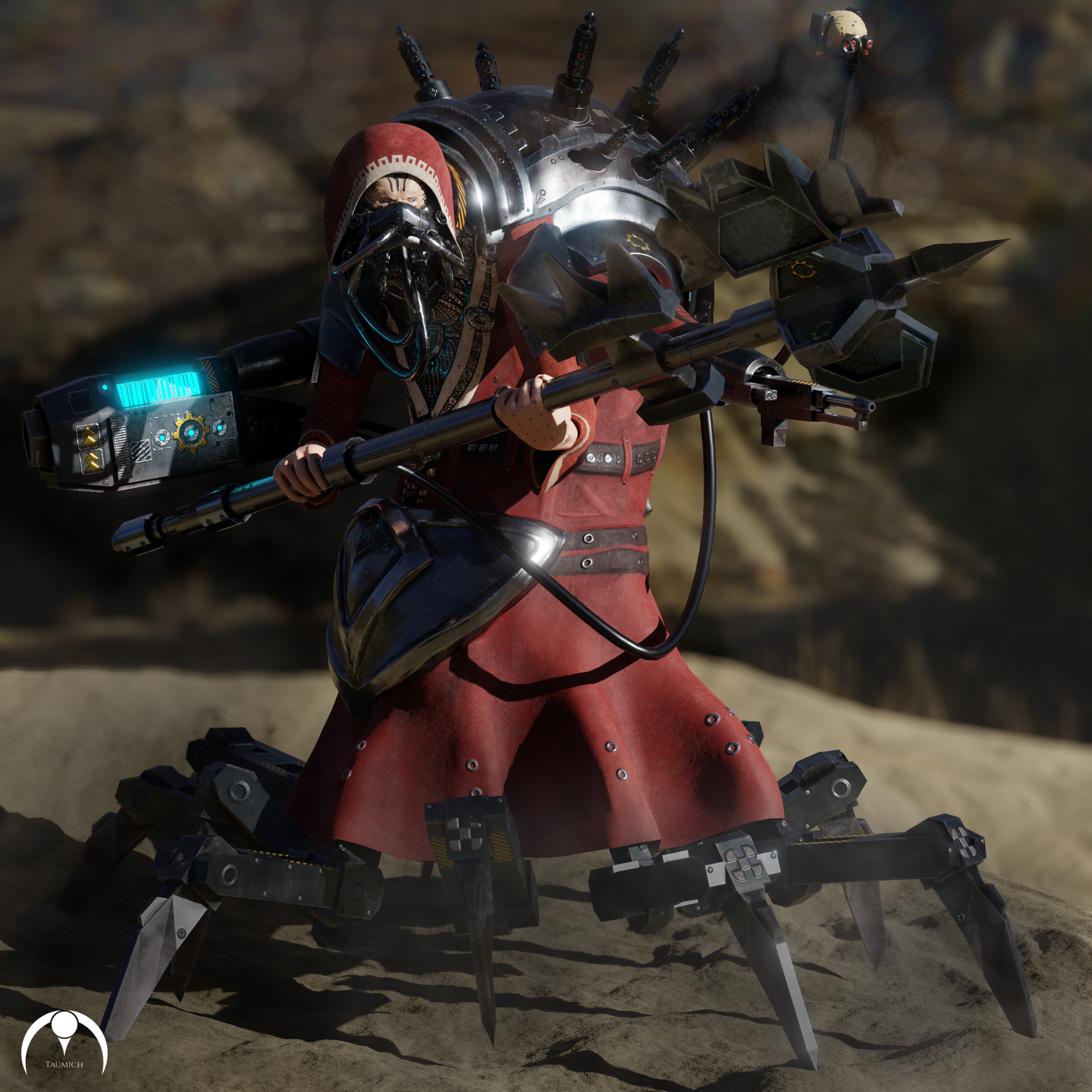In The Far Future, There Is Only War… An Intro to Warhammer 40k
By Gabriel Lopez de Azua
From the numberless hordes of the Tyranids to the towering God-Engines of the Collegia Titanica, Warhammer 40,000 (or 40k) is one of the most unique fictional settings out there. Its strong dark fantasy themes mixed with a unique take on science fiction help it stand on its own amongst the likes of other sci-fi giants such as Star Wars and Dune. Comprising a long-running franchise of numerous games, hundreds of novels, and numerous animations (as well as an upcoming television series starring Henry Cavill), it is a rising pop-culture phenomenon that has inspired numerous iconic games and novels for decades. But what is Warhammer 40k, and is it the right universe for you?
Shown here, the mighty Chaos Space Marines of the Iron Warriors and World Eaters repel an assault from the Tyranids
Warhammer 40k follows a simple narrative: the year is the 42nd millennium and humanity is beset on all sides by aliens, mutants, and heretics. Only the light of the God Emperor and his vast armies have allowed for the dogmatic Imperium of Man to gain a foothold against the relentless tide of enemies, the mightiest and most famous of said armies being the Space Marines. The greatest threat to humanity is not the hordes of Orks or extragalactic swarms of the insectoid Tyranids, but rather ourselves. Existing parallel to our own reality, a hellish dimension known as the Warp feeds off of human emotion and forms into sentient beings based on those emotions and thoughts. The inhabitants of this realm, for lack of a better term, are known as the Daemons and embody the worst aspects of humankind. Leading them are the four Gods of Chaos: Tzeentch, the Great Deceiver; Nurgle, the Plaguefather; Khorne, the Lord of Murder; and Slaanesh, the Prince of Excess. These deities of evil have their own twisted versions of humanity’s armies, the deadliest of which are the warbands of the Chaos Space Marines which roam the galaxy in search of slaughter. As long as humanity persists, so too will the forces of Chaos. The entire galaxy is locked in an endless stalemate as each faction’s power waxes and wanes, but never falters. In the grim darkness of the far future, there is only war.
First published in 1987 as a tabletop miniature wargame by Games Workshop under the title Warhammer 40,000: Rogue Trader (not to be confused with the later-released TTRPG and videogame of the same name), the game was actually a science-fiction adaptation of Games Workshop’s flagship game Warhammer Fantasy Battles (henceforth referred to as Warhammer Fantasy), which combined a Tolkienesque fantasy world with 80’s pulp fiction. Rogue Trader was much the same, taking the factions of Warhammer Fantasy and updating them to fit into a galaxy-spanning setting. This also applied to the rules, as the two were made to be cross compatible. Then, in 1989, Warhammer 40,000 2nd Edition was released. This was a radical overhaul from Rogue Trader, and forever divorced Warhammer Fantasy’s game system from its far future counterpart. As the decades progressed, new editions were released and with them came new armies, miniatures, and stories set in the 41st millennium.
The Imperial Knights of the Adeptus Titanicus are an excellent example of 40k’s evolution of lore and design. Properly introduced to Warhammer 40k in 2016 (though their very first appearances date back to 1990!), they have since had pivotal roles in many stories throughout the setting, and possess an ever-expanding model range.
Warhammer 40k has since diversified into many forms of media and continued strong into the modern day. But for many decades, it remained a niche hobby only pursued by a small number of players. Around the time of the Covid-19 global pandemic, however, Warhammer began to grow as a franchise with the release of two hit games (Adeptus Titanicus and Aeronautica Imperialis), and it has very recently soared into the mainstream zeitgeist through the success of the Space Marine II video game and the Secret Level anthology series.
40k’s rise in pop culture was driven by more than just the pandemic, though. Celebrity endorsements from big names like Henry Cavill and Vin Diesel have helped make more people than ever aware of Warhammer and encourage them partake in the hobby, and the launch of the new game edition (henceforward referred to as 10th edition) in 2023 has made it more accessible than ever before to possible newcomers.
But how does one play Warhammer 40k? As has been the case since inception, you play the game by purchasing miniatures from one of 40k’s many factions, then assembling an army and battling another player’s collection in large-scale conflicts. However, 10th edition has introduced some new ideas into the mix when constructing armies and building collections. Gone are the complexities of yesteryear, now in 10th edition army building is simple and fun. Simply choose a character unit available to your army to nominate as your “warlord” (this is the central character who leads your force), and fill the rest of your army with up to 3 of every other unit available to your faction. Each unit has a set “points” cost, which means that every army is built around meeting a set points value (most commonly 1000-2000 points of units). The sky’s the limit to what you can do with your army, ranging from massed infantry to hordes of aliens and monsters.
But the fun doesn’t stop there, as you can always change the weapons your units are equipped with! Referred to as “wargear”, this allows you to customize your units to fit any given purpose. Don’t think your Tech-Priest Dominus is deadly enough? Swap out his Volkite Blaster for an exotic Eradication Ray. Do you want your Blood Angels captain to have some scalding anti-vehicle weapons? Give him an Inferno Pistol and watch the chaos ensue. In 10th edition, you even have access to “enhancements”: unique abilities and power-ups you can give to a single character for an additional points cost. My favorite enhancement is Fleet Commander, which allows you to call down an orbital strike once per game and absolutely annihilate your enemies.
A Tech Priest Dominus of the Adeptus Mechanicus or “Ad-Mech”, seen here.
One of the most appealing features of Warhammer 40k was, to me, the broad range of factions available for people to select and play. There are 26 available factions in the game, from the myriad forces of humanity (and the humanity-adjacent Adeptus Mechanicus) to legions of aliens and eldritch horrors beyond mortal comprehension. There’s something for everyone, and the roster only continues to grow with new armies and characters to lead them being added. A key aspect of Warhammer’s model ranges is the ability to take what you like from one model kit and apply it to another. This can allow for some amazing converted game pieces, and is actively encouraged by Games Workshop. So even if you’re not interested in playing the Warhammer 40,000 tabletop game or reading the stories, you can still join the fun through modelling and painting your own unique units.
Warhammer 40,000 is a nigh-limitless realm where the possibilities for creativity are endless. Each facet of the hobby is its own domain with different skills to learn, and the community is more than happy to teach anyone willing. Whether you’re a fan of strategy games, love to paint, or want a creative outlet for storytelling, Warhammer 40,000 has you covered. So what are you waiting for? Start your journey today!



